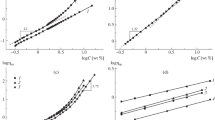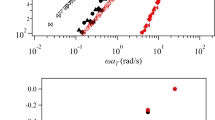Abstract
Linear viscoelasticity was studied for aqueous solutions of poly(acrylic acid) (PAA) complexed with ferric ion (Fe3+). Concentration of PAA was fixed in the semidilute regime, and concentration of Fe3+ varied within a wide range. Sol-to-gel transition was observed at low Fe concentration, and syneresis was observed at high Fe concentration. In between, the system was reversible gel with relaxation time governed by the effective breakup of the complexing sites. Analysis of stress relaxation behavior and temperature dependence enabled consistent determination of the association energy of ~ 75 kJ/mol. Syneresis at high Fe3+ concentration was associated with a decrease in solvent quality and increase in elastic energy with increasing density of the PAA/Fe3+ complexing sites.









Similar content being viewed by others
References
Cai J, Bo S, Cheng R (2004) Division of the concentration ranges of polyelectrolyte solutions. Acta Polym Sin 5:625–627
Cates ME, Witten TA (1986) Chain conformation and solubility of associating polymers. Macromolecules 19:732–739
Chen Q (2017) Dynamics of ion-containing polymers. Acta Polym Sin 8:1220–1233
Chen Q, Huang CW, Weiss RA, Colby RH (2015) Viscoelasticity of reversible gelation for lonomers. Macromolecules 48:1221–1230
Chen Q, Zhang ZJ, Colby RH (2016) Viscoelasticity of entangled random polystyrene ionomers. J Rheol 60:1031–1040
Colby RH, Boris DC, Krause WE, Dou SC (2007) Shear thinning of unentangled flexible polymer liquids. Rheol Acta 46:569–575
Colby RH, Rubinstein M (1990) 2-parameter scaling for polymers in theta-solvents. Macromolecules 23:2753–2757
Creton C (2017) 50th anniversary perspective: networks and gels: soft but dynamic and tough. Macromolecules 50:8297–8316
de Gennes PG (1979) Scaling concepts in polymer physics. Cornell University Press, Ithaca, N.Y
Dobrynin AV, Colby RH, Rubinstein M (1995) Scaling theory of polyelectrolyte solutions. Macromolecules 28:1859–1871
Dobrynin AV, Rubinstein M (2005) Theory of polyelectrolytes in solutions and at surfaces. Prog Polym Sci 30:1049–1118
Dou SC, Colby RH (2006) Charge density effects in salt-free polyelectrolyte solution rheology. J Polym Sci Pol Phys 44:2001–2013
Flory PJ (1953) Principles of polymer chemistry. Cornell University Press, Ithaca
Flory PJ, Rehner J (1943) Statistical mechanics of cross-linked polymer networks II swelling. J Chem Phys 11:521–526
Gong JP (2010) Why are double network hydrogels so tough? Soft Matter 6:2583–2590
Gong JP, Katsuyama Y, Kurokawa T, Osada Y (2003) Double-network hydrogels with extremely high mechanical strength. Adv Mater 15:1155−1158
Hamad FG, Chen Q, Colby RH (2018) Linear viscoelasticity and swelling of polyelectrolyte complex coacervates. Macromolecules 51:5547–5555
Kang Y, Wu XX, Ji XL, Bo SQ, Liu YG (2018) Strategy to improve the characterization of chitosan by size exclusion chromatography coupled with multi angle laser light scattering. Carbohyd Polym 202:99–105
Li JJ, Zhang ZJ, Cao X, Liu YG, Chen Q (2018) The role of electrostatic repulsion in the gelation of poly( vinyl alcohol)/ borax aqueous solutions. Soft Matter 14:6767–6773
Li ZH, Wu ZH, Mo G, Xing XQ, Liu P (2014) A small-angle X-ray scattering station at Beijing synchrotron radiation facility. Instrum Sci Technol 42:128–141
Obukhov SP, Rubinstein M, Colby RH (1994) Network modulus and superelasticity. Macromolecules 27:3191–3198
Pezron E, Leibler L, Ricard A, Audebert R (1988) Reversible gel formation induced by ion complexation .2. Phase-diagrams. Macromolecules 21:1126–1131
Radke W (2016) Consequences of on-line dialysis on polyelectrolyte molar masses determined by size-exclusion chromatography with light scattering detection. J Sep Sci 39:696–702
Rubinstein M, Colby RH (2003) Polymer physics. Oxford University Press, New York
Rubinstein M, Semenov AN (1998) Thermoreversible gelation in solutions of associating polymers. 2. linear dynamics. Macromolecules 31:1386–1397
Semenov AN, Rubinstein M (1998) Thermoreversible gelation in solutions of associative polymers. 1. Statics. Macromolecules 31:1373–1385
Sun JY, Zhao XH, Illeperuma WRK, Chaudhuri O, Oh KH, Mooney DJ, Vlassak JJ, Suo ZG (2012) Highly stretchable and tough hydrogels. Nature 489:133–136
Wei ZJ, He J, Liang T, Oh H, Athas J, Tong Z, Wang CY, Nie ZH (2013) Autonomous self-healing of poly(acrylic acid) hydrogels induced by the migration of ferric ions. Polym Chem-Uk 4:4601–4605
Yokoi H, Nomoto E, Ikoma S (1993) Reversible formation of iron(iii) ion clusters in the poly(acrylic acid)-Fe-3+ complex gel with changes in the water-content. J Mater Chem 3:389–392
Zhang Z, Huang C, Weiss RA, Chen Q (2017) Association energy in strongly associative polymers. J Rheol 61:1199–1207
Zhang Z, Chen Q, Colby RH (2018) Dynamics of associative polymers. Soft Matter 14:2961–2977
Zhang Z, Liu C, Cao X, Gao LC, Chen Q (2016) Linear viscoelastic and dielectric properties of strongly hydrogen-bonded polymers near the sol-gel transition. Macromolecules 49:9192–9202
Zhao JW, Mayumi K, Creton C, Narita T (2017) Rheological properties of tough hydrogels based on an associating polymer with permanent and transient crosslinks: effects of crosslinking density. J Rheol 61:1371–1383
Zheng SY, Ding HY, Qian J, Yin J, Wu ZL, Song YH, Zheng Q (2016) Metal-coordination complexes mediated physical hydrogels with high toughness, stick-slip tearing behavior, and good processability. Macromolecules 49:9637–9646
Zhong MJ, Wang R, Kawamoto K, Olsen BD, Johnson JA (2016) Quantifying the impact of molecular defects on polymer network elasticity. Science 353:1264–1268
Zou XT, Kui X, Zhang RC, Zhang Y, Wang XL, Wu Q, Chen TH, Sun PC (2017) Viscoelasticity and structures in chemically and physically dual-cross-linked hydrogels: insights from rheology and proton multiple-quantum NMR spectroscopy. Macromolecules 50:9340–9352
Acknowledgements
QC and ZZ thank the National Natural Science Foundation of China 21722407 and 21873095, respectively. YL thanks the Key Research Program of Frontier Sciences, CAS (QYZDY-SSW-SLH027). The BSRF is acknowledged for kindly providing the beam time.
Author information
Authors and Affiliations
Corresponding authors
Additional information
Publisher’s note
Springer Nature remains neutral with regard to jurisdictional claims in published maps and institutional affiliations.
Part of a Special Issue “Novel Trends in Rheology”
Appendix
Appendix
Figure 10 plots the master curves of G′ and G″ reduced at Tr = 30 °C against ω. The overall trend is the same as that shown in Fig. 5: the plateau modulus increased and the cross-point of G′ and G″ shifted to low ω with the increase of CFe.
Figure 11 plots the vertical and horizontal shift factors against 1000/T. One trend observed in panel a is that the temperature dependence of bT, which was explained in Fig. 6 as a decrease of number density of interchain association with increasing T. The T dependence of bT becomes weaker with increasing CFe, which seems to be a surprising result at first glance because the ratio of number density of interchain association at T and Tr should be ~ exp(Ea/R× (1/T – 1/Tr)), which is the same for all samples. However, we should remember that a change of plateau modulus with a number density of interchain aggregation is quite different for different scaling regimes during the gelation. For example, the gel point usually corresponds to 1/(Nblob-1), which corresponds to ~ 1 interchain association per chain when a number of blobs per chain Nblob is much larger than one. Above the gel point, double the number of interchain association from ~ 1 to ~ 2 per chain will lead to a significant increase of plateau modulus up to CPAART/M. In comparison, further doubling the number of interchain association from 2 to 4 per chain would only increase the plateau from CPAART/M to 3CPAART/M. This difference can be seen in Fig. 9 a where CFe dependence of GN is stronger for plots below CPAART/M (circles) than those in between CPAART/M and 8CPAART/M (squares). This difference qualitatively explains the lower temperature dependence of bT for samples of CFe ≥ 20 mM compared with the samples of CFe < 20 mM because CFe = 20 mM roughly corresponds to the full gelation point (i.e., two interchain associations per chain). The weakening of T dependence of bT with increasing CFe is in accordance with the slightly weakening of aT dependence with increasing CFe. The larger difference of bT in panel a than aT in panel b is mainly owing to a different vertical scales for two panels. The overall trend of aT against 1000/T is quite similar for all samples, which enable us to estimate consistent Ea of 87 ± 2 kJ/mol from the gradient (The highest and lowest gradients give Ea of 89 and 85 kJ/mol, respectively), and accordingly Ea of 71 ± 2 kJ/mol after subtracting the activation energy for motion of the water molecules.
Rights and permissions
About this article
Cite this article
Han, Y., Li, J., Zhang, Z. et al. Linear viscoelasticity of poly(acrylic acid) complexed with ferric ion. Rheol Acta 58, 513–523 (2019). https://doi.org/10.1007/s00397-019-01143-1
Received:
Revised:
Accepted:
Published:
Issue Date:
DOI: https://doi.org/10.1007/s00397-019-01143-1






